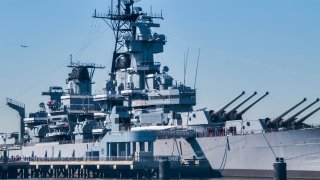Was the Iowa-Class Comeback in the 1980s Just a Giant Mistake?
No other warship in the U.S. Navy arsenal in the 1980s, or ever since, has possessed the ability to withstand punishment and dish it out quite like these fast battleships.
Was the Iowa-class battleships’ comeback in the 1980s just a giant mistake? Hell, no! No other warship in the U.S. Navy arsenal in the 1980s, or ever since, has possessed the ability to withstand punishment and dish it out quite like these fast battleships. Indeed, with a 61,000-ton displacement, 887-ft 3 in (270.43 m) hull length, and 16-inch (406 mm) guns, these warships were monsters; their 12.1-in (307 mm) belt armor, 19.5-in (495 mm) gun turret armor, and 17.3-in (439 mm) conning tower armor made them tough to crack.
But don’t worry dear readers, this is not going to be yet another debate about whether the Iowas should be returned to active service in the present day. Instead, I shall examine the battlewagons’ combat performance from the 1980s and early 1990s to prove why recommissioning them was a very good decision on the part of the U.S. Navy brass.
USS New Jersey (BB-62) and the Lebanon campaign
All four of the Iowa-class battleships were recommissioned at the direction of the U.S. Congress in 1981, which (perhaps not so coincidentally) was the first year of the Ronald Reagan presidency and Reagan’s more muscular defense policy. For good measure, the ships had their already-mighty 16-inch main gun arsenal further bolstered by Tomahawk cruise missiles, Harpoon antiship missiles, and the Phalanx close-in weapon system).
It was the USS New Jersey (affectionately nicknamed the “Big J”), i.e., the most decorated battleship ever, that gave the Navy, the White House, and Congress the first true validation and return on their investment.
As I noted in a previous article on the proud history of the USS New Jersey, on December 14, 1983, “Big J” fired eleven of her mammoth 16-inch projectiles at hostile positions inland of Beirut, Lebanon, in retaliation for attacks on U.S. reconnaissance planes by Syrian/Druze antiaircraft batteries. Two months later, Big J lobbed an additional 300 16-inch shells at Shiite and Druze terrorist sanctuaries in the hills overlooking Beirut, obliterating the general commanding Syrian forces in Lebanon and several other senior officers.
USS Wisconsin (BB-64) and USS Missouri (BB-63) during Operation Desert Storm
The 1991 Persian Gulf War (aka Operation Desert Storm) turned out to be the last combat hurrah for the Iowas, and they certainly went out with a bang.
New Jersey and Iowa missed out on this engagement, so their sister ships “Mighty Mo” and USS Wisconsin had all the fun shelling then-Iraqi dictator Saddam Hussein’s troops who were occupying Kuwait. Saddam’s troops started feeling the wrath of the Missouri and Wisconsin on January 29, 1991, twelve days after the multinational coalition initiated the use of military force. As noted by Naval History and Heritage Command:
“[Guided missile frigate USS] Curts, using advanced mine-avoidance sonar, led Missouri northward. Missouri gun crews sent 2,700-pound shells crashing into an Iraqi command and control bunker near the Saudi border. It marked the first time her 16-inch guns had been fired in combat since March 1953 off Korea. Missouri's gun crews returned to action 5 February, silencing an Iraqi artillery battery with another 10 rounds. Over a three-day period, Missouri bombarded Iraqi strongholds with 112 16-inch shells … Wisconsin, escorted by Nicholas, relieved Missouri on the 6th, answering her first combat call for gunfire support since March 1952. The most recently recommissioned battleship sent 11 shells across 19 miles of space to destroy an Iraqi artillery battery in southern Kuwait.”
Along the way, Wisconsin made additional military history by using an unmanned aerial vehicle (UAV) as a spotter in combat for the first time, proceeding to pound Iraqi targets and Iraqi boats that had been used during raids along the Saudi coast. As noted by the Dark Seas YouTube channel, some of the shell-shocked Iraqi troops actually started surrendering to the battleship’s drones (another historic first)!
Wisconsin's gun turrets went to work again on February 8, blasting artillery emplacements and bunkers near Khafji after the Iraqis were ousted from the city by Saudi and Qatari armor. Missouri and Wisconsin alternated positions on the gun line, using their 16-inch guns to destroy enemy targets and soften defenses along the Kuwait coastline for an amphibious assault that never actually came. Thus, in addition to the physical damage inflicted by “Mighty Mo” and Wisconsin, they pulled off a twofold psychological warfare feat: (1) the aforementioned pounding of the troops into surrender, and (2) compelling Saddam to commit a large chunk of his manpower for an amphibious assault that never occurred, thus enabling the U.S. Army general Norman Schwarzkopf’s famous “left hook” maneuver.
Where are they now?
Thankfully, all four Iowa-class battlewagons have been preserved for posterity and live on as floating museums. For starters, the “Big J” is moored, poetically enough, in the waters of her namesake state, more specifically Camden, New Jersey. To make a cool thing even cooler, the proud vessel recently underwent a $10 million restoration project.
USS Wisconsin is the centerpiece of the Nauticus maritime discovery center in Norfolk, Virginia, and (arguably the most famous of the bunch, as she was immortalized by serving as the site of the signing of Imperial Japan’s surrender) the Battleship Missouri Memorial is at Pearl Harbor, Hawaii.
Last but not least, there’s the tour I can personally vouch for: I’ve toured USS Iowa (BB-61) out in San Pedro (Port of Los Angeles/LA Harbor), California, multiple times since 2012, and can vouch that the tour never gets old.

